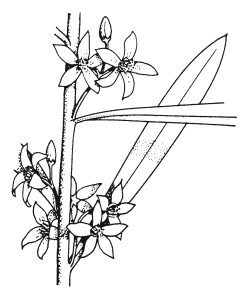Family:
Rutaceae
Philotheca myoporoides subsp. acuta
Long-leaf Waxflower
Syn: Eriostemon myoporoides subsp. acutus
Other Names: Native Daphne, Broad-leaf Waxflower.

Name Origin:
myoporoides — resembling Myoporum.
Regional Subspecies:
P. m. subsp. acuta
Occurrence:
Regional:
Noted in the areas: Narrandera-Morundah-Galore-Collingullie, and Upper Gilmore. Found in rocky outcrops and mountainous country.
Australia:
NSW.
Habitat:
Hilly areas with sandstone and quartzite. Chiefly in dry sclerophyll forest and heath.
Habit:
Shrub to 2 m high with densely warty stems and aromatic leaves, 25-40 mm long.
Site Preference:
Well-drained neutral to acid soils in dappled shade or partial sun. Tolerates frost, extended dry periods, semi-shade and full sun.
Characteristics:
Highly aromatic when crushed. Moderate growth rate and longevity.
Flowering:
White with pinkish tinge, mainly spring. Star-like.
Seed Collection:
Jan-Mar. Cut off mature fruiting capsules and dry in warm area to allow seeds to fall out. Seeds are short-lived.
Propagation:
From cuttings of firm new growth. May be slow and erratic to root. Bottom heat and overhead misting enhance or hasten rooting. Germination difficult. Seeds require nicking and leaching for 10-14 days before sowing.
VALUES:
Ornamental:
Popular in cultivation for shrubberies or mass plantings. Very hardy and adaptable. Light or heavy pruning promotes bushiness and mulching benefits plants. Scale and sooty mould may be a problem.
Other:
Cut flowers or foliage.
